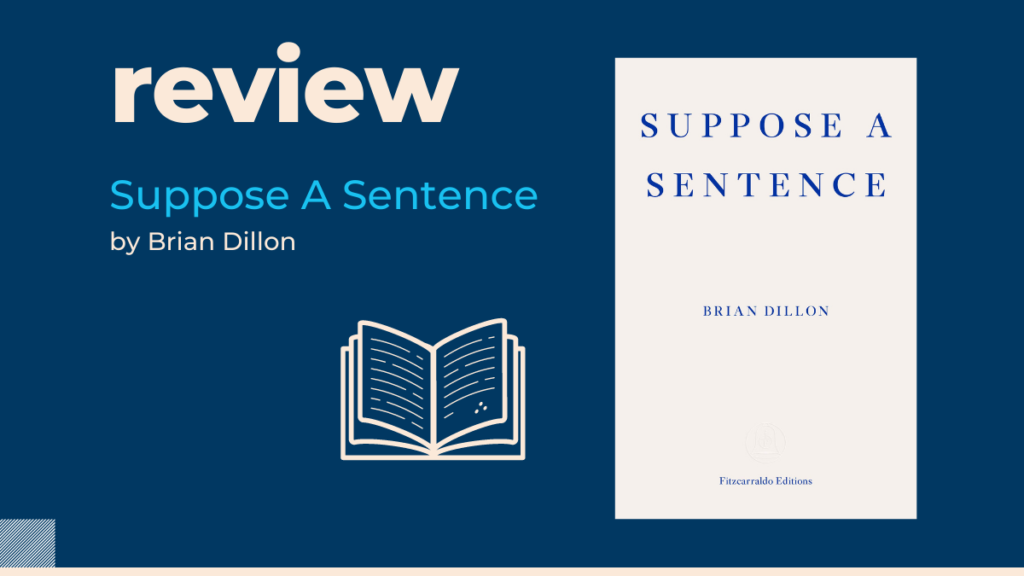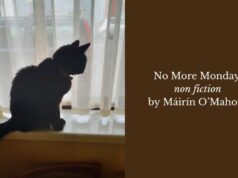
Suppose A Sentence
Brian Dillon | Fitzcarraldo Editions | PB £10.99 | 200pp | 9781913097011
“Patterns appear throughout the book, as if organically, like the concentric scratches on a surface when you shine a light to it. The scratches might hold no true order or logic, we know, but the focus of light draws an order from the chaos.”
‘Over Descartian vortices you hover.’ This is one of many sentences from Herman Melville’s Moby Dick that I’ve underlined, underlined for no real purpose except massaging my sense of intellect maybe, and drawing the line into relief, framing it in some way as a luminescent scrap of writing. What is that impulse to underline text, to draw from its surrounds, to admire?
Suppose a Sentence by Brian Dillon is built of this impulse, acknowledging and then interrogating it. The book is not a writing guide, but rather an exercise in pleasure—the pleasure of reading, the pleasure of writing. Dillon’s follow-on to 2017’s Essayism is an odd book, in that the subjects of its 28 chapters—sentences by different authors that Dillon has chosen from dozens of his own notebooks, a quarter-century of magpied-away slivers of prose—could have been swapped for 28 alternate choices, and I’m pretty sure the book would not have been diminished; the choices are in many ways incidental: the choosing, the holding to the light, the horology—that’s the glory of the text.
The connecting factor between the sentences he has chosen? ‘They compose a parallel timeline,’ he writes, a timeline of ‘affinity’: ‘these are the [sentences] that shine more brightly and for the moment compose a pattern’. Patterns appear throughout the book, as if organically, like the concentric scratches on a surface when you shine a light to it. The scratches might hold no true order or logic, we know, but the focus of light draws an order from the chaos. ‘I wrote, as it were, with my nose to the page, wrote for the first time in my life without a plan for the whole, wrote from one fragment to the next, feeling for the route that affinity might take me.’
At the level of the sentence, Dillon is both zealot and virtuoso. His choices of sentence are at times peculiar—although surely every randomised selection of 28 fragments would prove peculiar—primarily because he notes how some of them fail in their attempts to hold themselves together, or are indicative of a style forming, yet are not entirely of that style. The quotations and his exploration, dissection and analysis of them are, on the whole, fascinating—enlivening to any reader. Sure, some excel more than others: his selected sentences from Susan Sontag and Samuel Beckett left me maybe a little cold; which is to say still intrigued, but not near as impassioned as those on Annie Dillard, Janet Malcom, or Joan Didion left me. I wanted Dillon’s channel of passion trained at some other sentence of theirs, of course; each to their own.
In the opening preface to the book, Dillon tells us how ‘Beautiful sentences, William H. Gass wrote, are “rare as eclipses”. I went chasing eclipses: those moments of reading when the light changes, some darker lustre takes over’. The essay on Annie Dillard’s sentence, titled ‘A Ritual Feat’, focuses on a line from her 1982 essay ‘Total eclipse’ (see the pattern assert itself?). This essay on Dillard—much like the source of the sentence it is looking at—grapples with the capacity of language to describe, to conjure that which feels beyond us; in this case, an eclipse.
In ‘A Ritual Feat’ Dillon provides an astonishing simile as he writes of the sentence in question: ‘The sentence comes later, following totality and the shining miracle of an accompanying corona, in the aftermath of those deathly seconds, when the stone has been rolled away again.’ The essay, like many others in the collection, is a masterpiece and offered that recurring sense that there is always a level deeper, some ante-room of interest that Dillon can take us to in his search for understanding—an understanding not simply of what the sentence is about, but of what the sentence is doing, what fruit it’s reaching for. If the chosen sentence is itself an eclipse—one he has been chasing, one I’ll let the reader chase too—then when the stone is rolled away again at the essay’s conclusion, the reader is left dazzled, blinking, retinas marbled. (For an oblique connection to this—a pattern, you might say—read the quotation Dillon has chosen from Middlemarch, ‘red drapery […] spreading itself everywhere like a disease of the retina’.)
Where Dillon’s Essayism often looked to the sentence as a way to understand the essay, Suppose a Sentence turns to words to enrich the sentences’ meanings; he offers us a glimpse—through an understanding of the layered meaning of their etymology and use—of the genius of the sentences’ authors. I think here of the essay on James Baldwin, which explores Baldwin’s use of the word ‘ofay’ to squash Norman Mailor; or Charlotte Brontë’s use of ‘wrought’ in her three-word sentence (three words that, for Dillon, act as a keyhole to a cathedral): ‘The drug wrought’.
Dillon generally doesn’t arrive at the sentence in question in each of the essays until several pages in, often tendering an approach from the higher ground of context—personal or literary. This context is constructed with an airy economy of language that never weighs the essays down. Dillon dances a line between materialist and formalist examinations of the texts, between subject and object. He makes sure we are aware that he is aware of the context surrounding these texts, but that’s not to say the context is what concerns him most; he is after the art of the form, the play of the light.
There is an aspect of the book bound to the language of photography—as there often is in Dillon’s writing; he is a master at writing the image—to positioning the sentence as an image. The book itself is an inversion of a Susan Sontag quote, which he features in its opening section: ‘A photograph could also be described as a quotation, which makes a book of photographs like a book of quotations’. In this case, our book of quotations can be seen as a book of photographs, of images.
Dillon’s style is the real luminescence of the book: it is joyful, indulgent, engaged, a rapt pleasure (see his epigraph from Roland Barthes). ‘I wanted to write a book that was all positives, all pleasure, only about good things,’ he states at the book’s opening, and it seems that he’s succeeded. In the essay on Joan Didion, Dillon hazards a definition of style as ‘verifiable presence on the page, a question of materiality’. His own presence throughout the book? Unquestionable.
***
Stephen Reid works in editorial with New Island Books and sales with Brookside Publishing Services.












